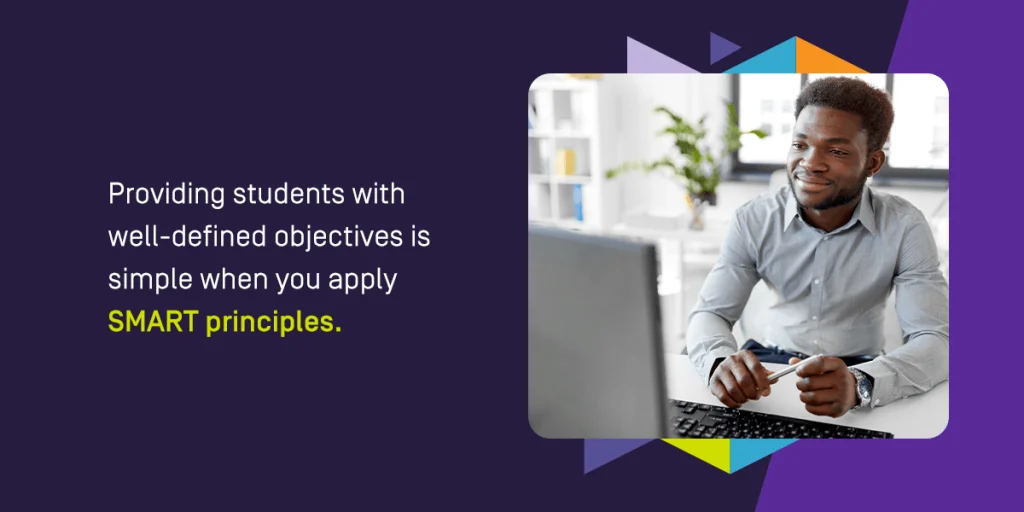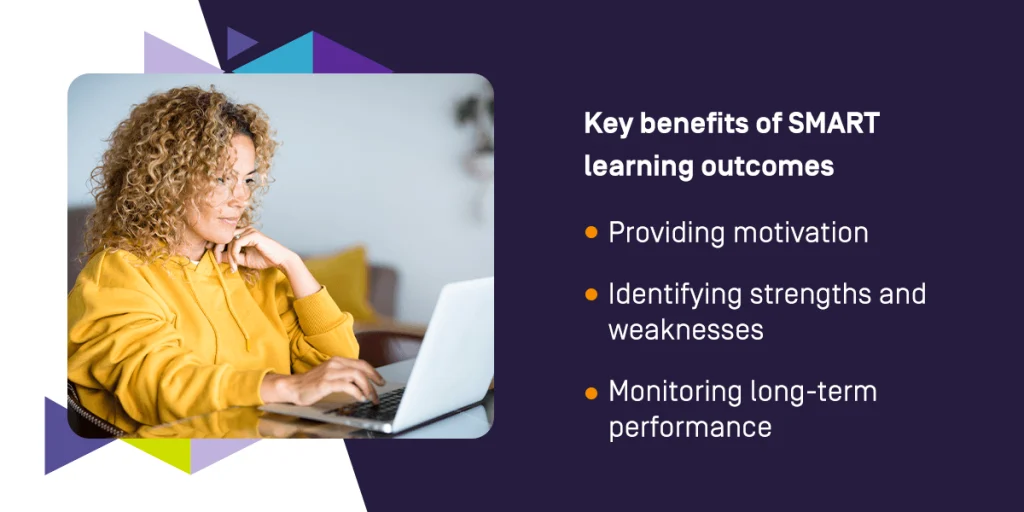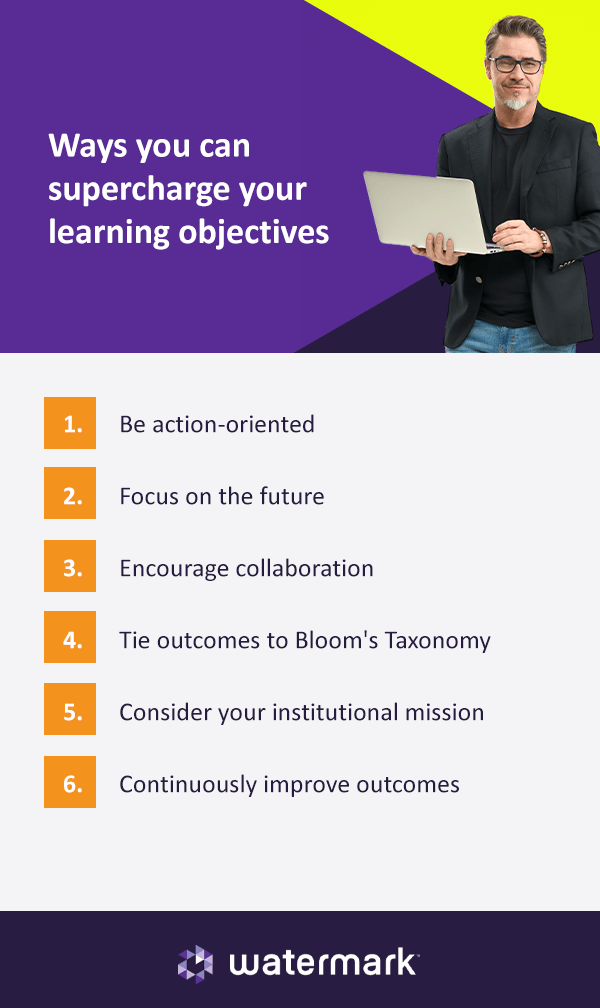Outcomes help higher education institutions track and measure student progress as they move through courses or programs of study. At the most fundamental level, an outcome states what you want to achieve and how you’ll know when you get there. While academic outcomes define expected behavior or knowledge that a student will demonstrate after they complete a course or program, non-academic outcomes focus on skills and accomplishments outside of student learning.
Writing outcomes can be more difficult than you think. We are sharing how to write a student learning outcome that makes it easy to track and support learner progress.
How to create learning outcomes
Understanding how to write good learning outcomes is crucial for higher education institutions for various reasons, including:
- Setting clear expectations: Learning outcomes provide students and instructors with important guidance on the skills, knowledge, and competencies a course should provide.
- Curriculum alignment: Colleges and universities can use learning outcomes to inform curriculum development and ensure coherence among activities, lessons, and assessments.
- Effective instruction: Faculty members can use learning outcomes as benchmarks for success, helping them determine if their instruction strategies are actively supporting student achievement.
- Quality assurance: Having clear learning outcomes helps institutions meet accreditation requirements and ensures high-quality educational experiences for students.
- Managing student engagement: Predetermined learning outcomes help faculty gauge student engagement and implement prompt strategies to improve motivation and success.
Providing students with well-defined objectives is simple when you apply SMART principles. SMART stands for specific, measurable, achievable, relevant, and time-bound.

Learn more about the key elements of an effective, trackable SMART learning outcome:
Specific
When creating learning outcomes, be highly specific and concrete. Avoid vague, broad, or general goals. These often do not provide the best guidance or direction for learners.
Instead, describe the desired outcome in terms of what students should know and be able to do at the conclusion of a course or program. Each should focus only on one idea or expected behavior.
Measurable
Effective learning outcomes are measurable and offer clear insight into student performance. When crafting outcomes, establish criteria for achievement that are easy to verify.
Your institution should be able to identify whether or not a student is meeting course or program standards easily and objectively. The data you use to measure student learning outcomes should be accurate and reliable.
Achievable
An essential consideration when learning how to write course learning outcomes is achievability. While your institution should aim to set motivating and challenging objectives for students and faculty, establishing realistic, attainable goals is the key to success.
Relevant
Relevancy is another element of an effective learning outcome. Consider how a learning objective directly benefits students and supports their achievement in a particular field of study. Establish goals that make sense with short-term and long-term success.
Time-bound
Learning outcomes should tie back to a specific time frame. This helps motivate students and teaching staff to work efficiently to cover the course or program content effectively in the predetermined period.
Time-bound goals offer structure and help institutions gauge and monitor learning progress throughout the year.

Key benefits of SMART learning outcomes
Applying the principles of a SMART goal to higher education learning outcomes can be highly advantageous. Explore the primary benefits of implementing thoughtful and detailed objectives:
- Providing motivation: SMART outcomes guide students and faculty members, keeping them focused and motivated on the end goal. They provide a destination that guides important decision-making and helps your institution boost academic achievement.
- Identifying strengths and weaknesses: Establishing SMART learning outcomes is also an effective way to pinpoint opportunities for improvement. They make it easier to track performance so your institution can intervene and provide additional support for struggling students.
- Monitoring long-term performance: Another advantage of employing SMART learning outcomes is having benchmarks for success year after year. Your institution can compare teaching methodologies with student performance to determine ways to improve curriculum design in the long term.
Taking student learning outcomes from good to great
Once you understand how to write a learning outcome that encompasses SMART principles, why not take your institution’s outcomes from good to great? Explore the ways you can supercharge your learning objectives:

1. Be action-oriented
While developing your learning outcomes, focus on making them action-oriented. An effective way to do this is to start your outcome statements with strong verbs.
For example, student learning outcomes for a marketing course may include:
- Apply key branding principles while developing a new marketing campaign.
- Communicate the value of market research and consumer insights.
- Create brand pillars for marketing a business and its products or services.
Apply, communicate, and create are keywords here, and they demonstrate what students should be able to do upon course completion.
2. Focus on the future
As your institution develops learning outcomes, it is important to consider the future and how an industry, discipline, or career path may differ in the years to come. Students need preparation for life after graduation, and your college or university will benefit from forward-thinking goals.
As technology rapidly evolves and the labor market shifts, it is important to implement learning objectives that give students expertise and skills that are desirable to employers.
3. Encourage collaboration
Another way to improve your learning outcomes is to ask your institution’s faculty and students for feedback. You can gain valuable insight into your curriculum design and what teaching techniques work well.
While crafting and updating your objectives, consider how you can better support the success of both instructors and learners. Their feedback can guide your decision-making and offer thoughtful considerations you may otherwise overlook.
4. Tie outcomes to Bloom’s Taxonomy
Bloom’s Taxonomy can be an incredible resource for developing highly effective learning outcomes.
From lowest-order to highest-order thinking skills, the taxonomy includes:
- Remember: Recalling specific information accurately.
- Understand: Grasping the deeper meaning and implications of the material.
- Apply: Using the information to understand similar but unique situations.
- Analyze: Identifying important relationships and frameworks.
- Evaluate: Creating judgments and coming to informed conclusions.
- Create: Utilizing the information to create something brand new.
When you write outcomes to align with the levels of knowledge-based, skills-based, or affective
(“affective” here referring to values, attitudes, and interests) taxonomies, it is much easier to determine which assessment techniques are most appropriate for measurements.
5. Consider your institutional mission
As you write a student learning outcome, it is important to consider your larger institutional mission. How can you tie your course and program goals to your vision for the future? Student achievement will benefit both the individual and your college or university as a whole.
6. Continuously improve outcomes
You can optimize your learning outcomes by continuously seeking opportunities to improve them. Fostering a culture of assessment is one of the best ways to support long-term institutional success.
By seeking new ways to refine and update your learning outcomes to better suit diverse learning styles, the labor market, and advancing technologies, your college or university can provide students with the most effective educational experience possible.
Request a demo of outcomes assessment software from Watermark today
When your college or university is ready to take advantage of assessment to supercharge its learning outcomes, turn to the solutions from Watermark. We’ll help make the process simpler and more manageable so you can focus on what matters most — student success.
With Watermark Outcomes Assessment Projects, higher education institutions can streamline assessment data collection with intuitive rubrics. Our solutions will make your standards reporting dynamic, insightful, and relevant. We’ll help you track student progress and stay organized for higher achievement.
Ready to get started? Request a demo of the higher education software solutions from Watermark today.

Need guidance in writing great outcomes? Check out Assessment Foundations: Developing Quality Outcomes & Objectives, and then request a demo of Watermark’s Outcomes
Assessment Projects solution to see how to streamline your assessment data collection with intuitive rubrics that will make your standards reporting dynamic and insightful.















































































































































































































































































































































































































